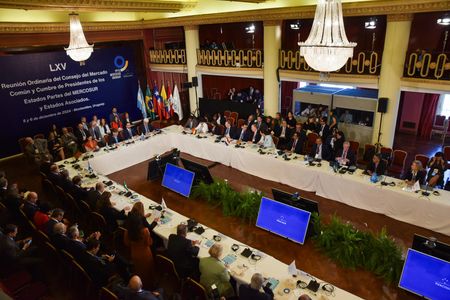MONTEVIDEO (Reuters) – The European Union and four South American countries on Friday finalized a free trade agreement that took over two decades to negotiate.
Before implementation, however, the accord faces a key test in Europe amid stiff resistance from France and some other EU members.
WHAT COMES NEXT?
The Mercosur bloc’s four founding members – Argentina, Brazil, Paraguay and Uruguay – have signaled support for the agreement, which each can implement once its national legislature approves.
In the European Union, the process is more complicated.
After legal review and official translation of the agreement in coming months, the EU may split it up to speed ratification.
The core trade deal could be fast-tracked with approval by a simple majority of EU lawmakers and a qualified majority of EU governments, meaning 15 countries representing at least 65% of the EU population.
To block that process, at least four EU members representing more than 35% of the EU population would need to oppose it.
France will look to rally resistance and may find support from Austria, Poland and the Netherlands. Together they account for around 30% of the EU population, so they would need to find more opponents to block the deal.
Germany, Spain and nine other EU members, together home to about 40% of the EU population, have urged negotiators to reach a deal this year.
Implementation of the wider political accord between the trade blocs, including new rules for cross-border investment, would likely require approval by national parliaments in the 27 EU member countries – a much longer process.
WHAT IS AT STAKE?
Leaders have touted the accord as the world’s largest trade and investment partnership, bringing together a market of more than 700 million people. Economists estimate the deal could do away with 4 billion euros ($4.8 billion) of tariffs annually, which are likely to be phased out over several years.
The accord should help Europe export more autos and manufactured goods, while securing access to minerals crucial for its energy transition. It should also lower trade barriers for South American meat and grains, which has angered European farmers.
WHAT HAS TAKEN SO LONG?
Negotiators agreed to a version of the trade deal in 2019, which European nations refused to ratify, citing environmental concerns after the election of former Brazilian President Jair Bolsonaro and a surge in Amazon rainforest fires.
The EU sought assurances on environmental policy in a side letter, which Mercosur countries took as fresh protectionism requiring other concessions in further rounds of negotiations.
Recent talks in Brasilia and Montevideo finally bridged the gap on environmental protections, government purchases and other hot button issues, clearing the way for the new deal to be signed.
(Reporting by Anthony Boadle in Brasilia, Philip Blenkinsop in Brussels and Lisandra Paraguassu in Montevideo; Editing by Brad Haynes, Alistair Bell and Christina Fincher)

